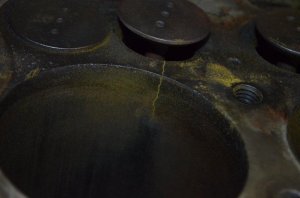- Home
- About Us
- Join/Renew
- Member Benefits
- Member Pages
- Log In
- Help
- Museum Store
Hello all,
We are in the process of rebuilding the engine in my 133 Club Brougham. A previous owner bought a core from John Cislak last year (thanks, John!), as this original one had a couple of cracks from overheating. Ironically, the sad part is that the original engine, which we have no history on, had clearly just been rebuilt and done very well. This is a car that was well cared for, exept for the bullet hole in the rear…
David Coco was nice enough to sell me a copy of the owner’s manual, which is a great help, but it does not provide the technical specs for the engine. Does anyone have, and would they be willing to provide, more detailed specs of the engine? We can do the babbit bearings and all machine work, but it would be nice to have a lead on the valve and cylinder sizing, crank and cam bearing specs, valve detail, etc.? Any and all info and/or leads would be appreciated.
By the way, I had sent my clutch off to Fort Wayne Clutch to be rebuilt. They did a fabulous job and turned it around in less than a week. The car still has the original throwout bearing (1/29 date code), and they couldn’t find a replacement. It seems fine, but would be nice to replace if one is available. Any leads?
Thanks,
Bob Coates
703 628-1190 (EDT)
For a source for throw out bearings, check the Parts & Services
section listed under Member Pages of this website. It is one
of the major reasons for belonging to the P.A. Society and is a
beacon to other car clubs to show a way to assist their members
to keep their cars road-worthy.
Hello Bob, rebuilding these engines is a mater of machine work, measuring and fitting parts to provide proper oil and expansion clearances.
Back when these engines were built and maintained, a mechanic ‘knew’ from experience what was the correct torque for various bolts, the correct clearance for lubrication etc..
For example, if a set of main bearings were poured, then line bored, then the crankshaft was fitted and the main bearing caps installed, the bearings slowly and carefully tightened while turning the crankshaft. if a particular bearing, when tightened cause the crank to bind or have excess friction, the crank was removed, and both the crank surface inspected, and the bearing surface inspected, usually there is a ‘high spot’ in the babbit bearing and the bearing is carefully clearanced with a hand scraper, a tedious job, but needed to prevent metal to metal contact on the bearing and a gauled or seized bearing.
Cylinder bores were hand honed to provide piston to cylinder expansion clearance, rings’ end gaps hand files to provide a proper gap
In today’s engines, there are specs to grind a crankshaft to, to match the precision made bearing inserts, and these usually fit near-perfectly with precise oil clearance.
So to a great extent, you will need to use what parts from the old engine in the new engine block and machine the new block to fit, If your new block’s cylinder bores are smaller than the old engine’s pistons, either new pistons need to be purchased, or if the old ones are obviously new and good quality, then bore the new block to fit.
The new block will need new mains poured and line bored, but the old crankshaft’s rod bearings and rod journals if properly done in the past should be reusable, but a thorough and careful inspection is needed.
Hope this explanation helps..
Greg L
If Ol’ Car Bearing could not supply this bearing for you, I would be surprised. George is very accomadating. Not real inexpensive, but not unreasonable either. Access to him should be all over.
I want to get a response in before we lose power here in DC for another 4 days… Thanks for all the responses thus far, and to Chris Diekman for sending me a great PAS article on the ’31 engines. It is excellent.
As for the throwout, I may try the original one as it really looks and feels good, but it is worth getting a new one as a spare. The only issue in this area is the grease leaking from the front of the transmission. Unless you all have any war stories to convince me otherwise, I will clean the tranny and replace the front bearing cover with a new custom made gasket.
Now back to the engine. As the work was done so well on the original block, we are likely to fix it. The cracks are on cylinders 2 and 3, and run between the cylinder and the valve. The fix would be to bore the cylinder for a sleeve, and the valve for a hardened insert, then use the LocknStitch method before final boring for the sleeve and insert. Thoughts are appreciated on this method. I am an engineer, and shy away from the welding process from past experience.
I will try to send a few pics of the cracks for you to view in a separate posting. The files are too big, and have crashed the post a few times.
Thanks again for all your interest and help!
Bob
Picture of the cracked block after magnafluxing.

John Cislak has the bearings in stock….. they are not very expensive. Give him a call. Ed
Send picture to Lock-N-Stich. They have an excellent engineering staff who could advise better than most of us. They know Pierce Engines!
Thanks. Mitch, the machinist, has already emailed them, but hasn’t gotten a response, to my knowledge. Perhaps you will fare a bit better. If you do, please forward it on to me.
